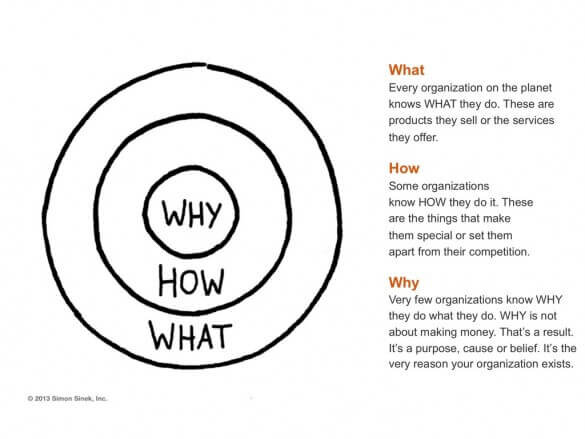5 ground rules for marketing messages that no one ever talks about
You already know when you’re looking at an effective marketing message.You have that “aha!” moment. A soft-focus image of what your life could be like if you could get your hands on this product or service comes into focus. All of a sudden, the idea of living life without this product seems unbearable. You’ve seen the light and you cannot go back.
You grasp for a reason to talk yourself out of reaching for your credit card, but you can’t think of one. There really is no good reason not to act now!And that's how you end up with a $225 carry-on suitcase you weren't planning to buy.
Your messaging challenge: overcoming inertia
Why is it so easy for us to ignore some marketing messages while others make us feel truly, madly, deeply compelled to buy? Because inertia. There is a LOT going on in our heads working overtime to keep us from pulling the trigger.
People hate change. We have a long and messy list of reasons to resist it. We feel anxiety about changing existing behaviors. We feel like we don’t fully understand where this “new thing” fits into our lives. We may be considering doing other things with our money (it's limited, after all).Even if we get past all that, we may feel like we can put off making a final decision. You know, why not wait until tomorrow or next week? If a marketing messages isn't strong enough to overcome inertia, it doesn't make the sale.But effective marketing messages work differently.They spark curiosity and intrigue. They make us confront pains.
They anticipate our objections. They seem to know our problems better than we do, and seem to hold answers too. We can't help but tune in for more.So how do you manufacture these things? Let's look at these examples I've collected across B2B and B2C marketing - because they all follow a handful of principles that we can apply to our own work.
How to write an effective marketing message
1. Don’t try to explain everything at once
When I was Head of Growth at ProdPad, my company would sponsor a booth at Mind the Product conference to promote our product management software to product managers.Talk about an easy sell, right? Not so. In the first year, our pitch to conference attendees went something like this:
“ProdPad is product management software that does everything you need for your job as a product manager. You can use to build a theme-based product roadmap, prioritize your product backlog using customer feedback that you can gather from many different sources.”
We believed at the time that that quickly communicating that we do everything that product managers need would be a major selling point. Who doesn’t want an all-in-one solution that does all these things?:
Product backlog management
Product roadmapping
Customer feedback management
Except this didn’t work. I watched overwhelmed conference attendees squint as they tried to wrap their heads around this sweeping claim - an extremely concrete indicator that our messaging needed to be tapered down.For the next conference six months later, I came up with a more refined pitch:
“ProdPad is designed to help product managers lead their teams using a product roadmap everyone understands.”
I made the bet that paring down our message to focus on our single, most compelling benefit would help us have more productive on-the-ground conversations. It meant we were “sacrificing” talking about ten things at once, but that was counterproductive anyway. We may have wanted to prove that we could do everything, but "roadmaps everyone understands" was the one thing that consistently perked up the ears of potential customers.
So did it work? Yes! The message clicked. People stuck by our booth longer. They came by and signed up for demos long after we had run out of swag - a sign that we were getting this right.Albert Einstein said “If you can’t explain it to a 6-year old child, you don’t understand it yourself.” Live by this rule even if your target market isn't 6-year olds.
No one falls for a product because it's a “powerful solution" that “does it all.” No one gets excited about "end to end solutions for X." Even if you have (or plan to have) the most powerful product in the world, resist the urge to pile it all on at once.Instead, kick off the pitch with your most compelling benefit or insight. If it’s good enough, people will want to stick around to hear out the rest of your story.
2. Embrace the messy nuances in your customers' lives
As marketers, we do customer interviews. We develop user personas. We do surveys and questionnaires. We do this to get to know our customers.With all this amazing, in-depth data in our arsenal, I’ll never understand why marketers revert back to the laziest possible language:
“We’re the world’s best…”
“We’re the #1 solution for…”
“We’re the first end-to-end platform that…”
Why go to such great lengths to be this bland? Why this fear of being relevant to people? Is anyone actually reading Seth Godin or are we all just faking it for LinkedIn? Do what that man says.
No one is ever looking for the “world’s best” anything. We are all looking for someone to understand us and solve our problems.
That's why articulating a problem is such a wildly successful strategy. It wins you immediate trust and credibility. It builds proof that you deeply understand your customers and are therefore the best positioned to solve them. As consumers, we don’t always bother to diagnose our own problems. We suffer mild inconveniences and annoyances. We kvetch here and there. But we also grudgingly accept that things are the way they are, a thorn on your side that you can live with. It’s not until someone comes along and forces us to confront our problems that we perk up and say, “Hey, that sounds a lot like what I need!”
I'm going to ask you again: Would you rather buy “The World’s #1 Best Suitcase” or the suitcase that enables your crippling need to overpack? As a marketer, you probably already spend time researching your customers. Now, lean into it. Legitimize the messy, nuanced lives of your customers by mirroring their problems, dreams and desires back at them. Embrace the details. It's what draws people in. It's what gets them to believe you're the answer.
3. Don’t talk about yourself
Allowing yourself the indulgence of talking about your business is as annoying as it is useless. Don't believe me? Watch this 2-minute clip of the CEOs of Microsoft and Publicis Group announcing a new partnership called "Marcel."
Those were two minutes of your life you will never get back. We learn that Satya and Arthur are very excited about something, but pray tell, what is it? What on Earth are these two prattling on about? Wtf is Marcel? Who should care, other than Satya and Arthur? It's too bad no one stopped this.
Someone had to set up this interview, edit the clip and distribute it on social media. It was all in vain.Speaking of vanity, you're a marketer! You must hone the instinct to not use marketing channels to talk incessantly about yourself. Your customers don't care about you. They care about themselves and their problems. THAT is what you should be talking about.
If you can't imagine what that would look like, let's look at some examples together. In the following Slideshare, you'll find three good ways to sell your business without talking about yourself:
👉🏽Higher order customer concernsWhat do your customers care about that you can help them with? (Side note: Xerox turned around sales numbers for an entire vertical using this strategy)
👉🏽Name an enemyWho or what is the enemy that is getting in the way of your customer’s happiness? (Side note: Andy Raskin notes how essential this element was for Elon Musk's Tesla pitch)
👉🏽A major, undeniable shift taking place in the worldWhat’s changing in the world that you can prove? (Side note: I highly recommend Doug Kessler’s “Irresistable Content for Immovable Prospects”)
4. Bring the fire 🔥
Simon Sinek’s Golden Circle concept (a.k.a “Start with Why”) is a useful framework for defining your business’ purpose and core beliefs.But once you know what you stand for and what makes you different, then really stand for it. With pathological confidence, if you dare. In other words, bring the fire. 🔥
When you bring the fire, you light up the room with a message so confident and disruptive that it's nearly impossible to ignore. You come to the ring with fighting words. This can really work in your favor when you enter a saturated market.
Let’s use backpacks as an example. There are lots of high-end backpack brands on the market already, like Sandquist, Herschel and Bellroy. Is there room for more?
There sure is! The runaway success of Använda, a Kickstarter project is proof of that. Having branded themselves as being a “great fucking bag,” they breezed past their original $12k crowdfunding goal, ending up with over $1.2 million.
Why did so many people back this project? My best guess is that there's a segment of consumers who want a solid backpack but don't identify with pretentious, overpriced backpack market. (Full disclosure: I backed this project.)
Använda's brand talks to them. It's honest, blunt and acts like it couldn't be bothered to develop a classy brand like the others on the market. It turns its back on all that, choosing an "anti-marketing" marketing pitch that doesn't put on airs.
Who else has been bringing the fire? Transferwise. Transferwise's marketing message is more or less a strongly worded indictment of banks. No pussyfooting here, just a lot of fire. (For comparison's sake, check out my Transferwise vs. WorldRemit messaging teardown to see just how shatteringly bold Transferwise's messaging is.)
By the way, bringing the fire doesn’t mean you have to cuss or force yourself to be irreverent for the sake of irreverence. Take a look at the quiet, cheeky confidence of Ford Motors as they promoted their bestselling convertible in the 1970's:
If you know what sets you apart, if you really know what's special about you...then go for it. Light a fire. Let it burn.
5. Make it clear where you fit into people’s lives
Selling something new and innovative? Then the onus is on you to show your potential customers where you fit into their lives and what you intend to replace, complement or change.
Let's look at Drift, which entered the extremely saturated and competitive sales/marketing software market around two years ago. (We've all seen that insane Martech landscape supergraphic, right?) How did they manage to break through all that noise? By establishing context.
When you're introducing a new concept or a different way to do an existing job, context matters.
What existing products, attitudes or behaviors are you working to change?
What will life look like after they switch to you?
What's the net benefit of switching to you vs. retaining the status quo?
Drift does something achingly simple to address all three. First, they establish their competitor as the status quo, which they brand as the "Traditional Marketing/Old Way." Then, they introduce "Conversational Marketing/New Way," a word they made up. (Making up words in marketing is fine, as long as you take the time to help your audience understand it.)
Then they put them next to each other so we can compare. This isn't groundbreaking stuff! It's just a comparison chart! But Drift's comparison chart does its job - it shows you what it intends to replace and exactly how it fits into your sales and marketing process.
You don't have to spend a lot of time figuring out Drift's value proposition - and that gives them a strong advantage in the marketing game.
Context is not a little detail. It is the most essential detail of them all. Your audience requires this detail to help them evaluate whether you're the right product for them. So why make this hard for them? Why force them to put two and two together? Why make them have to use up their cognitive energy to figure out why they need you in their lives?
For the love of god, tell them what your company does. Don't assume that your customers will just "get it." Your business does not exist in a beautiful little vacuum where no other options exist. There are always other products or solutions that could get the job done in the eyes of your potential customers.Accept it and address it.
One last thing...
Messaging is no cakewalk! It takes a lot of research and iterating to develop a core set of marketing messages - and you don't even get to keep it for very long! Myk Pono suggests revisiting your strategic messaging every six to twelve months.










